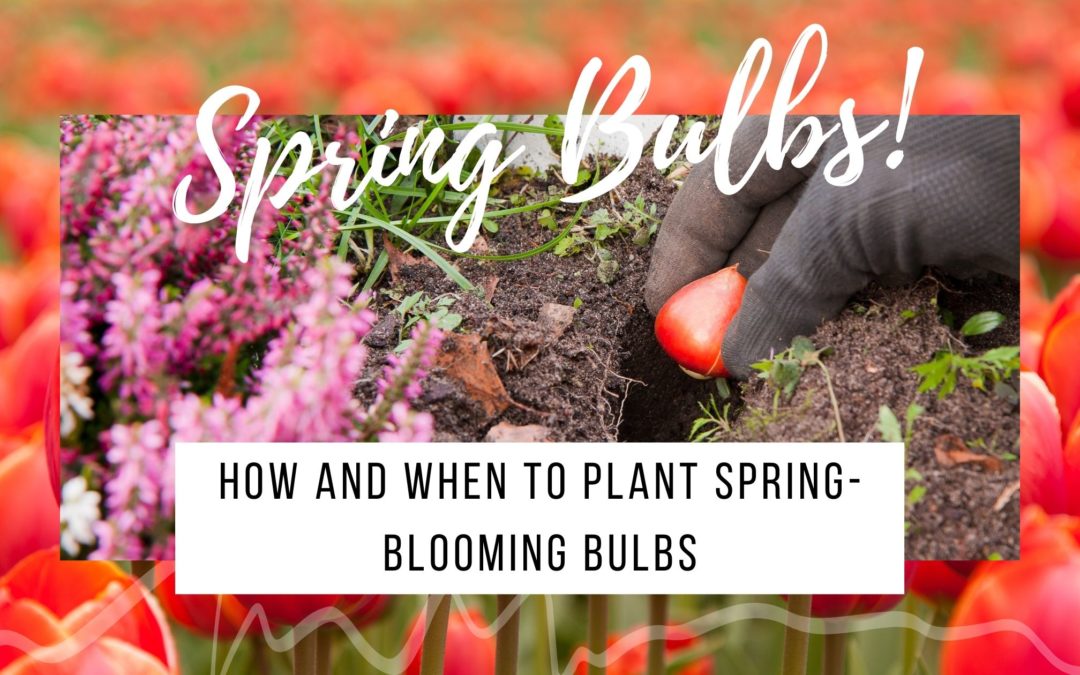Each year you plan and prep and decide to plant spring-blooming bulbs or, maybe it’s your first time and you’re finally thinking ahead. You can’t wait for all of those beautiful tulips, daylilies, irises, and daffodils to come up in the spring. But when do you plant them and how? Even in December around the Pacific Northwest, we really haven’t had any super cold weather so our ground is still quite malleable. Here’s how and when to plant spring-blooming bulbs.
Why we need to plant spring-blooming bulbs now.
To break its dormancy and actually bloom, most of the spring-blooming bulbs like tulips, daffodils, crocus, and hyacinth must be exposed to temperatures of 40°F or colder for at least 12 to 14 weeks. These cold temperatures stimulate them to start working on flower formation and will initiate root growth. Most of these spring-flowering bulbs can be planted in soil for several weeks before the ground freezes but you don’t want to plant them too early as they could actually start sprouting before winter sets in.
Sending up foliage too early will deplete the bulb’s energy it needs to get through the winter and then bloom perfectly in spring. We are in the landscape of Zone 8 and even though it’s considered a warmer client, anything from about 7 or 8 and higher, you might consider purchasing pre-chilled bulbs for the best success.
However, sometimes we have a right around Zone 7 and we usually do get a few days of freezing temperatures, but pretty much, just one or two days below 40° is all you need to really jumpstart that bulb for next year. Because we are on the line between Zone 7 and 8, planting in November and December is actually fine for most spring-blooming bulbs.
You want to plant before the ground freezes. As long as you can get your shovel in the ground, you can plant your bulbs. If you’re planting late in the season, consider planting a few inches deeper than recommended for added insulation. You want to mulch the bulbs with a few inches of leaves, evergreen boughs, or another type of mulch just to protect them.
If the ground has already frozen and this will is too hard to dig, you might be better off purchasing pre-chilled bulbs and then tuck them away until spring.
Other spring-blooming bulbs like dahlias and gladioli should be stored away for winter like in a garage or shed. Spring-blooming bulbs will need to develop some roots and experience a period of chilling to be able to sprout and flour for the next season.
If the ground has already frozen, you can pot them up. You can plant the bulbs in large containers filled with potting soil and simply leave them outside as long as they’re not pressed up against the sides of the pot where they could actually freeze and then rocked. Make sure there’s plenty of soil between the sides of the pot and the bulbs. Stored in an unheated garage, porch, basement window well, or right next to the house.
Water the bulbs about once a month and then move the pot outdoors in mid-spring and let the bulbs bloom and do their thing.
You could consider planting on top of the ground. Spread your bulbs out on top of the ground and cover with at least 6 to 8 inches of potting soil. However, this might attract chickens and rodents to dig up your bulbs and eat them so you may need to put some chicken wire or fencing over or around where you planted the bulbs just to be safe.
Where to plant spring-blooming bulbs
If the area has good drainage and sunlight, you can plant them just about anywhere on your property. Drainage is crucial to keeping the bulbs from rotting. They like loamy or slightly sandy soil because it provides the best drainage and nutrients. Early spring-blooming bulbs can be planted under deciduous trees will go get enough sun to bloom before the tree’s leaves block out the sunlight.
Plan before you plant.
The best way to plant spring-blooming bulbs is to plant them in clusters, formal gardens, and take into account the bloom of time. You may want to plant bulbs that grow first in other areas versus ones that bloom a month later. You can hide dying foliage of low-growing bulbs that are past their prime with taller bulbs planted in front or with companion plants.
Lasagna planting
This is a unique way of planting that’s ideal for bulbs of different sizes. You stagger the bloom times in layers for continual bloom. This works great in large containers and can be used in-ground as well. Feel free to talk to us about the best way to lasagna plant your spring-blooming bulbs.
Remember, we can certainly help plan your spring-blooming yard next year by coming out and offering a consultation today. Feel free to contact us at any time.
Call First Fruits Landscaping for all of your Pacific Northwest landscaping, gardening, and yard maintenance needs. Would love to help you design and prepare your garden or landscape for the entire year.

